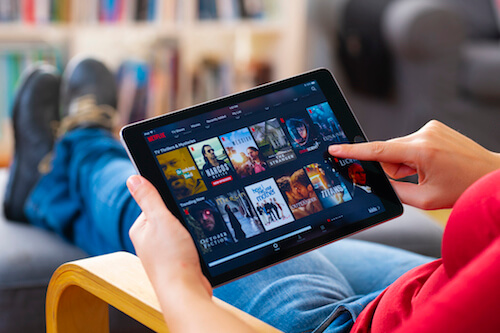We answer how many Mbps you should get and the best internet providers for remote workers
The Best Internet Setup for Working from Home
Did you recently ditch the nine-to-five grind in favor of remote work and find your internet isn't quite up to the job?
Don't worry. We'll help you determine how much download speed you need based on your work-from-home duties, streaming habits, and number of devices connected to your Wi-Fi.
We have tips to optimize your internet setup for working from home based on real-life experience and hands-on research. Plus, we've got tips on making your connection more secure and setting up your home office.
Best internet service providers for remote work
We have one 5G home internet provider, two fiber internet providers, and two cable internet recommendations. Fiber is limited across the US, and broadband internet can have a lower price tag for those who want to save money.
We like T-Mobile 5G Home Internet because it's affordable while still delivering solid speeds for a small household. This plan is also perfect for the home office because it's easy to set up and comes with unlimited data. Plus, you get perks as a new customer, including a discount on your plan if you also have a T-Mobile cellular plan.
AT&T Fiber because it has the best price for gigabit speeds (1000 Mbps for $80 per month). Verizon Fios is limited in the US, but if you need gigabit speeds, this internet service provider has the best price tag.
As for cable internet, Comcast Xfinity is our favorite cable provider overall. Its internet speeds are reliable, available across the United States, and has the best value. Spectrum Internet—an ISP also widely available—has a little bit of a higher price tag for the speeds you receive, but you don't have to sign a contract.
You can use our zip finder below to find out if these internet providers are available where you live.
What kind of internet do I need to work from home?
First, let's find out how much download speeds, or Mbps, you need, and then we’ll get into the recommended internet service providers (ISPs) for working from home.
If you’re searching for a new ISP to support your remote job, you’ll want to look for reliably fast download and upload speeds and at least one terabyte (TB) of data per month.
- Download speeds: Download speeds reflect how quickly you can access things online. Faster download speeds will load your websites, fuboTV channels, and work email more quickly.
- Upload speeds: Upload speeds tell you how quickly you can put things on the internet. Faster upload speeds will get that PDF attached to your email instantly and keep your face from freezing during your Zoom
- Data: Everything you do online uses data with streaming and downloading large files typically using the most data overall. Most internet providers allow you to use at least one TB of data each month—but some offer the holy grail of unlimited data.
Here’s a quick look at some general recommendations for how fast your download and upload speeds should be for different work apps (and HD-quality video).
If you transfer files through Google Drive, Dropbox, WeTransfer, and Send Anywhere, small files only require 1–5 Mbps. Large files will need 25 Mbps.
As you can see, the requirements for these apps are far from the 100, 200, or even 1,000 Mbps some internet plans offer. But if you’re working from home while your partner, roommate, or kids are using the internet, too, you’ll want more speed to ensure everyone stays connected and happy.
For more guidance, check out our How Much Internet Speed Do I Need? guide.
You can use our speed test to find out what your current internet plan offers you regarding download speeds. If you're paying for speeds much faster than the speed test says your download speed is, it might be time to call your ISP or search for a new provider.
What’s a good internet speed for working from home?
We recommend a minimum of 50 to 100 Mbps download speeds for working from home and at least 10 Mbps upload speeds if you upload large files to the internet.
You'll be OK with 25 Mbps if you work from home and do not upload large files, like streaming on YouTube, attending video conferences, or delivering graphic designs to clients.
However, as soon as you add more people and more devices that all use the internet with you, you’ll want more speed. If you are a YouTuber, photographer, or graphic designer, or if you hop on many video calls, you'll want to look for faster download and upload speeds.
Trust me, go cheap because you want to avoid dealing with the frustration of everything running sloooow.
Is 50 Mbps enough for working from home?
We mentioned that 50 Mbps is a good starting speed for working from home, especially if it's just you hopping online. And it's enough to forward cat videos to your friends or stream a couple of Succession episodes on your downtime.
At these speeds, you can add another person who enjoys streaming and works from home, too, as long as everyone's online tasks are light.
But we’d recommend looking for 100 Mbps or faster once you’ve got three people who enjoy surfing the internet during their work-from-home breaks or if anyone handles large documents, like PDFs, PowerPoints, or videos and graphics.
Is 100 Mbps good for working from home?
Download speeds of 100 Mbps should be enough if you plan to jump on Zoom meetings, peruse the internet, and send files.
And when it’s time to hang up your hat and change into your second pair of pajamas, 100 Mbps is perfect for zoning out to episodes of Yellowjackets while your partner plays Roblox and your teenager watches YouTube videos.
Feel free to use our speed test to see what download speeds your current internet plan provides.
Is 200 Mbps good for working from home?
If you’ve got a smart home system and a family that loves to spend most of their time online, whether working or not, then 200 Mbps is likely a good internet speed for you.
We highly recommend this download speed to large households and internet power users. You know, the livestreaming, game-playing, constantly-streaming folks.
If you’re unsure on whether you fall into this category, check out our guide on how many Mbps you need.
Should remote workers use a VPN?
A remote worker can benefit from using a VPN service to prevent malware attacks and protect your privacy. A VPN hides your location and your personal data from hackers.
So, a VPN provides security, privacy, and anonymity.
But one thing we should warn you about is that a VPN can slow down your internet. Exactly how slow your internet becomes will depend on your internet speed before the VPN, how far away you are from your VPN server, and which VPN service and encryption you use.
Our favorite VPN services include NordVPN, ExpressVPN, CyberGhost, Private Internet Access, and Hotspot Shield.
What do I need for a good home office setup?
You may need to tweak or create a new office setup if you're working from home. You don't have to spend thousands to do this, but it's always worth the money to ensure you're comfortable while working.
These are our recommendations for work-from-home equipment:
- Keyboard: Logitech K480 | Redragon S101
- Mouse: TECKNET Wireless Mouse | Apple Magic Mouse
- Mousepad: Precise Mouse Pad
- Headset: Sony ZX Series Stereo Headset
- Monitor: ViewSonic 27-inch Monitor
- Laptop stand: BESIGN Laptop Stand
- Mac hub: USB-C Hub Multi-Port Adapter
- Chair: Padded Mid-Back Office Chair | Furmax Mesh Desk Chair
- Standing desk: VIVO 32-inch Standing Desk Converter
The Logitech K480 keyboard is wireless, so you can place it on the table or your lap while reclining. It works with Windows, Macs, iPads, Android, and ChromeOS. The Redragon S101 is a gaming keyboard that comes with a gaming mouse—and they're both backlit.
The TECKNET Wireless Mouse fits nicely in your hand, has a 24-month battery life, and only costs $9. If you want an Apple Magic Mouse to pair with your Mac laptop or monitor, you can go the little more expensive route. Remember to monitor your mouse’s battery life because you’ll want to charge it while you’re not working—its battery port is underneath.
The Sony ZX Headset is convenient because it has a microphone on its wire for Zoom calls—that means no stick-like microphone in front of your face. It's lightweight, has padded ear cups, and the band won't squeeze your head. The audio quality is also pretty excellent for a low-cost headset.
The 27-inch display of the ViewSonic Monitor is the perfect size to see everything while dragging, dropping, typing, and researching while working. And the Laptop Stand makes sure you don’t angle your head down while you work, so you don’t have neck pains after you hop offline.
For those who use a laptop and monitor simultaneously, the USB-C Hub Multiport Adapter allows you to connect your Mac laptop to your monitor (of any brand).
The Padded Mid-Back Office Chair and Furmax Mesh Desk Chair are consumer favorites. These two office chairs are affordable options most remote workers will be happy with, but if you tend to have neck or back problems, investing in a more expensive chair might be something you should consider.
The VIVO Standing Desk Converter allows you to sit or stand while you work to get blood flow through those legs to prevent back, knee, and hip issues.
Make sure you work and play in separate space
One drawback to working from home is that your office may also be your relaxation center. For example, if you're into PC gaming during your downtime in the same area where you work, you never fully disconnect from work.
If possible, I highly recommend setting up a separate space for working, reading, eating, scrolling on social media, and streaming. That way, you can physically detach from work when it’s time to “go home.”
The final tips for working from home internet connection
If your current internet speed can't keep up with Zoom calls, consider upgrading plans or internet service providers.
We recommend an internet plan with 25Mbps minimum to handle your Zoom calls—but if you run a home office, more download speed will make everything run smoothly. Take a peek at our guide to internet speed for easy tips on calculating what speed you need.
If you want to speed up your internet connection without upgrading, use an Ethernet cable. Wi-Fi is great, but it tends to lose strength if you put a lot of distance and objects between your device and the router. Nothing beats a good old Ethernet cable connection if you want the fastest speeds.
So what else can you do about slow internet speed? Aside from calling your internet service provider (ISP), you can try the following:
- Restart your router. Restarting your router flushes out any memory errors that might interrupt your internet connection or slow it down.
- Buy a new router. If your router is older, it might be time to upgrade it. Newer routers are better equipped to keep your internet speed moving along quickly. Not sure where to start shopping? Take a look at our favorite routers.
- Try some of our other tips for speeding up your internet. From repositioning your router to clearing your cache, we have 10 tips to speed up your internet service before waiting on hold with your ISP.
Related Articles




